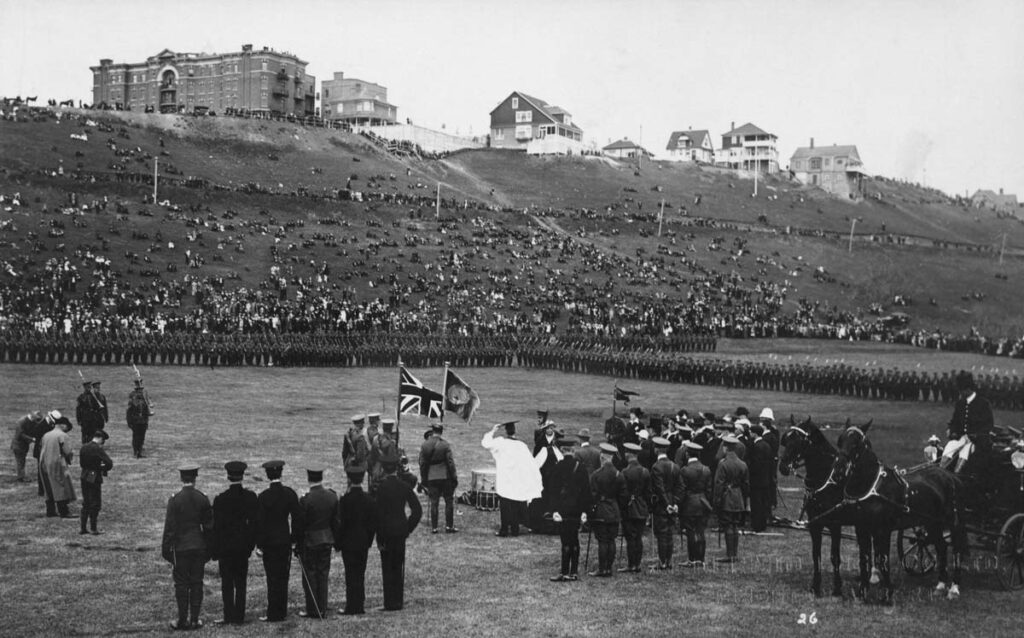In 1964, Lieutenant-Colonel G. R. Stevens, OBE, published an account outlining the very special role of Edmonton’s 49th Battalion at the Battle of Vimy Ridge in his book A City Goes to War: History of the Loyal Edmonton Regiment (3 PPCLI). Stevens was born in Nova Scotia and graduated from the University of Alberta in 1915. He served for three years with the Princess Patricia’s Canadian Light Infantry and was wounded twice.
In Spring 1917, soldiers from the 49th Battalion were involved in the elaborate preparations for the Battle of Vimy Ridge. This included an extensive re-vamping of the Vimy tunnels thought to have been built in the Middle Ages by French Protestants – the Huguenots – to avoid Catholic persecution.
The Grange Tunnel, built by the 7th Brigade, was 686-metres-long and had three exits near the jumping-off trenches. Like other tunnels, it had a tram-line system with electric lights, a water supply, as well as accommodation for soldiers, dressing stations, and magazines housing mortar and other ammunition. The tunnels protected the assault troops from shelling and allowed men & supplies to get to the front and wounded to be brought back. Electricity was provided by generators and the tunnels were also supplied with telephone lines. The network was an incredible feat of Canadian and British military engineers.
The Germans also had built tunnels, for example, the Volker Tunnel on the eastern slope of the ridge which was mined to prevent capture. Fortunately, Canadians were able to deal with the mines as they captured it. The Zivy Cave, a former chalk quarry held by the Germans, could hold a whole battalion. Brigadier General Rennie of the 4th (Canadian) Brigade was headquartered there on April 9, 1917. A Canadian soldier housed there noted that water dripped from the ceiling wetting everything below and creating pools of “greyish-white slime” on the ground.
Once the tunnels were completed, soldiers of the 49th as well as other battalions trained on model trenches built to scale. On March 9th, Prime Minister Sir Robert Borden came to inspect the work and encourage the troops. Borden came to believe that it was Canadian heroism at battles in 1917 and 1918 that strengthened Canadian nationhood.

Photographer: McDermid Studio, Edmonton, Alberta. Image Courtesy of the Glenbow Archives, NA-2470-2.
When the attack came, the 7th Brigade went in with three battalions – the Royal Canadian Regiment on the right, the Patricias in the centre and the 42nd Battalion on the left. Stevens writes:
The Forty-Ninth therefore was odd man out but this in no sense implied a subordinate role. With deep dugouts, saps, strongpoints and other hideouts abounding it was obvious that the assault battalions, moving on a rigid timetable, dare not halt to root out any obdurate nests of defenders. This task devolved on the Forty-Ninth. For weeks it had been practising mopping-up tactics, detecting and destroying isolated groups of the enemy, maintaining the flow of vital supplies and messages, evacuating the wounded – in all particulars playing Universal Aunts to the assault battalions. Such training had been interspersed with working parties which familiarized officers and men with the organization of the battle front. It was as intricate as a great factory, with a multitude of services to maintain, to improve upon and in emergency to by-pass with direct aid to the fighting men.
On April 9th, Stevens notes: “Approximately half the Forty-Ninth strength – seven platoons organized as mopping-up squads – went over the top with the first wave of the attack.” He continues, “By 1100 hours almost every man of the Forty-Ninth was engaged in the forward zone, either as garrisons for the assault units or as escorts or carriers – prisoners down, ammunition, food and stretchers up. At nightfall those who had returned from other duties were sent forward anew as stretcher bearers.”
Stevens concludes: “The progress of the Canadians from valorous amateurs to battle-tried professionals had been swift and sure. They always had known how to die when facing the enemy; now they had learned how to live and how to destroy him.”

By Adriana A. Davies, CA, Cav. D’Italia, PhD

